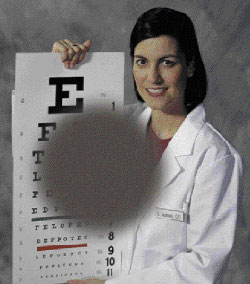Daniel C. McCarthy, Senior News Editor
Macular degeneration is a leading cause of vision loss in people over the age of 60. Although the disease is incurable, early detection can limit the scope of its damage. Unfortunately, current diagnostic methods, such as angiography, are costly and invasive, which discourages many seniors from committing their limited health-care resources to preventive checkups. Scientists at Schepens Eye Research Institute hope to make diagnoses easier and more accessible using technology originally developed to speed network communications.
The institute's prototypical technique, called multiply scattered light tomography, uses a 3 × 3 array of VCSELs from Picolight Inc. The emitted light that is scattered by the retina passes through a confocal aperture and is detected by an avalanche photodiode. The nine lasers are arranged in a square configuration and emit 850-nm pulses in an alternating pattern -- first the outer eight lasers, then the single inner laser -- at a 4-kHz rate. An image captured from one pulse is used as a reference point for the other.
"If you alternate the confocal image with the image from scattered light, then you can track where you are [on the retina]," explained Ann Elsner, who is a senior researcher at the institute and developer of the instrument.
Typically, macular degeneration is signaled by leaking or swollen blood vessels beneath the retina or by dead or dying cells at its center. "A healthy retina is flat and has well-defined layers," Elsner added. "Any change from that, and you know there's pathology."

People afflicted with macular degeneration cannot see objects directly, but must rely on peripheral vision. The disease cannot be cured, but it can be slowed and even stopped if detected early enough. Toward this task, VCSELs have proved to be an enabling technology.
Angiography can detect faulty blood vessels, too, but, in addition to costing about $400, it requires that patients be injected with a fluorescing dye and sit through a prolonged and uncomfortable imaging procedure. Further, patients can experience allergic reactions to the injected contrast agents. Once commercialized, Elsner's technique could cost $50 or less per test.
Earlier, Elsner and others had explored the use of infrared light-emitting diodes as a light source, but beam divergence can vary enough between axes to cause astigmatism and loss of contrast in the image. Conversely, VCSELs emit circular beams, providing more even energy distribution and a more uniform divergence profile.
Elsner's technique, still under evaluation in a Florida clinic, was integrated into an ophthalmic device manufactured by Laser Diagnostic Technologies Inc. in San Diego.